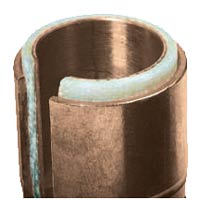Understanding MIG Welding Nozzles

insert, as shown in this cut-away, can help extend
the life of the consumable. The brass insert,
in particular, helps maintain the inner diameter
of the nozzle and reduce wear.
Welding gun nozzles play a critical role in the welding operation. Having the right nozzle for the job can help reduce weld defects, rework and associated downtime — while also extending consumable life. All of these factors impact the bottom line.
Unfortunately, like other MIG welding consumables, the importance of selecting the right nozzle is often overlooked. In any welding application, the right shape and style of nozzle, however, can have a significant impact on the quality, productivity and overall cost of the welding operation. Knowing how to store and handle nozzles properly can also help improve their overall performance. Consider these tips to get the best results.
Selecting the Right Shape of Nozzle
There are several shapes of nozzles available, including straight, bottleneck and short or long taper nozzles. Straight nozzles typically have larger inside diameters (e.g., 3/4 inch), but don’t offer as good of joint access. If greater joint access is critical, a bottleneck nozzle may be the better option. These nozzles are particularly good for automated welding applications. A common inside diameter for a bottleneck nozzle is 1/2 inch.
Short and long taper nozzles are also common choices for gaining good joint access. Note, that long taper nozzles typically have a smaller inside diameters and may collect spatter more readily. When possible, using a short taper nozzle can help prevent such a problem.
When selecting a nozzle, it is important to find one that provides the best joint access for the application. It is also imperative that the nozzle allows for the proper gas flow to the weld puddle in order to keep contaminants away. The best choice is to use as large of a nozzle as possible that still allows access to the weld joint. Doing so helps ensure the greatest shielding gas flow. Larger nozzles are also less prone to collecting spatter compared to those with smaller inside diameters.
A Simple Guide to Selecting the Proper Nozzle
| Welding Application | Nozzles Considerations |
|---|---|
| Welding Current |
|
| High Heat |
|
| Limited Weld Access |
|
| Heavy Spatter Generation |
|
| Using Nozzle Cleaning Stations |
|
1For extreme heat applications, consider water cooled nozzles/guns.
Selecting the Best Material

build-up, as seen here, and cleaning it
properly can help extend the life of the
consumable. Adding anti-spatter can also
help prevent build-up.
Nozzles are typically available in heavy-duty or standard styles, and in slip-on or thread-on varieties. Heavy-duty nozzles have thicker walls, as well as thicker insulators, and are designed for use in applications ranging from 400 to 600 amps. Due to their heavier construction, these nozzles resist heat better than standard varieties. Standard nozzles tend to have a thinner wall and are better for 100- to 300-amp applications. Slip-on nozzles, as their name implies, simply slip on to the front end of the MIG gun. These nozzles are quite prevalent in the industry, compared to thread-on nozzles that need to be twisted to install, and they offer the advantage of being able to change over more quickly. A note of caution: when installing slip-on nozzles, be certain that they are fully seated on the retaining head to prevent shielding gas leaks that could lead to poor weld quality.
Nozzles are typically available in brass or copper, although chrome-plated nozzles are also available. Brass nozzles tend to resist spatter well and are good for lower-amperage applications (100 to 300 amps), whereas copper nozzles are better for high-amperage applications (above 300 amps) or for those with longer arc-on time.
For high-amperage water-cooled applications, there are also nozzles available that circulate coolant around the nozzles, but these tend to be much more expensive.
Proper Storage, Handling and Maintenance
It is important to handle, store and maintain nozzles properly to gain consistent welding performance and prevent premature failure. Selecting high quality nozzles can help these consumables last longer, too.
Look for nozzles that are engineered with a smooth surface finish and edges, as these resist spatter build-up compared to nozzles that have an uneven surface or burrs on the edges. Nozzles that have some mass to them are also more desirable than lighter or thinner ones since they tend to resist heat better. Also, consider purchasing nozzles that feature a brass insert. This insert helps the nozzle maintain its inner diameter, and prevents the nozzle from rocking and wearing prematurely. The addition of a high-temperature fiberglass insulator can also help extend nozzle life. Finally, look for heavy-duty crimping on the nozzle — the crimping holds the layers together and is an indication that the nozzle has been built for longevity.
Storage
When storing nozzles, keep them in their original packaging, usually a small plastic bag. Removing them from that packaging and placing them in a bin can lead to scratches or dents that allow spatter to adhere and will ultimately shorten the life of the nozzle. Use gloves when handling nozzles or replacing nozzles to prevent dirt, oil or other contaminants from adhering to them and inadvertently entering the weld puddle.
Handling
Periodically inspect the nozzle for spatter build-up and clean it using the tool recommended by the manufacturer as needed and/or consider using an anti-spatter compound to protect against spatter.
Maintenance
As with any front-end consumable, nozzles play an important role in maintaining good weld quality and can have a measurable impact on productivity and costs, too. Take the time to select the right ones for each application and maintain them properly. Careful selection and maintenance can minimize downtime and keep your welding operation running more smoothly in the long run.
Select From Available Tregaskiss Nozzles